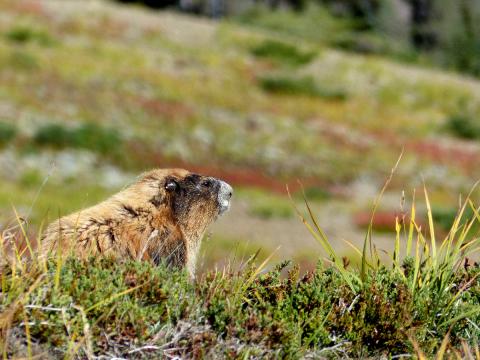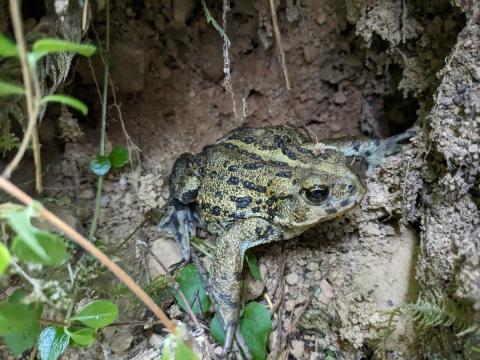
The Best Time of Year to Visit Olympic National Park for Wildlife Viewing is from April to October
April, May, June, July, August, September, and October usually bring warmer, drier weather to the Olympic Peninsula. Precipitation in the form of fog or a light drizzle, adds to the sublime natural experience at all times of the year and can be beneficial for Olympic National Park wildlife viewing.
Read more about spring, summer, and fall wildlife viewing courtesy of Wildlife Guide Carolyn, Port Angeles, WA who is the owner and guide of Experience Olympic.
Spring Olympic National Park Wildlife: April, May, and June
Early spring in the lowlands of Olympic National Park starts in March and continues to be the best time of year for viewing Roosevelt Elk near Olympic National Park and a great time to visit the Hoh Rainforest after a winter of precipitation.
Spring is the best times of the year for viewing and photographing Olympic National Park waterfalls and rivers. Banana Slugs, amphibians, snails, and other terrestrial invertebrates are often seen during the spring season as temperatures increase and humidity levels remain high. Chorusing frogs are heard around ephemeral ponds that are necessary for breeding semi-aquatic amphibians.
Spring Olympic National Park continued
Spring bird migration results in excellent Olympic National Park bird watching opportunities.
Olympic National Park wildflowers start blooming in the mountains as days lengthen and snow recedes. Subalpine wildflowers will continue blooming through the summer as long as moist soil conditions remain. Peak wildflowers at Hurricane Ridge (at just over 5000 feet) can be as early as the end of June. However, peak wildflower season varies each year due to seasonal temperatures influencing snowfall and snowmelt. Experience Olympic has organized a spring wildflower guided small group tour package that highlights lush green spring vegetation and wildflowers that will fade over summer.
Spring Olympic National Park continued
May and June are generally the best time of year to visit Olympic National Park in order view Black Bears. During the spring, these fascinating large mammals start to become active and viewed near Hurricane Ridge where they eat the early spring plant growth.
The season for accessing the high country, including Hurricane Ridge, generally starts in May. As the snow melts, the Olympic Mountains come alive with Olympic National Park wildlife like Olympic Marmot, Columbian Black-tailed Deer, Olympic Chipmunk, Snowshoe Hare, butterflies, and breeding birds.
Summer Olympic National Park Wildlife: July and August
If sunny weather is important to you, then summer is the best time of year to visit Olympic National Park. The month of July historically has the lowest level of average monthly precipitation.
Summer is a great time to enjoy breeding birds like Tufted Puffin, which disappear offshore after breeding. Olympic Peninsula's Puffin breeding season is roughly June to August, which is why we have organized summer small group guided birding tour packages. In early July, songbirds will still be singing (their songs fade later in the month) and shorebirds will return from breeding in the far north.
Summer Olympic National Park continued
Although you will often enjoy sunny weather and scenic mountain scenery during the summer season, many of the typical Olympic National Park terrestrial invertebrates, such as Banana Slugs, will not emerge under low humidity conditions.
Spring and summer are the best time of year to visit Olympic National Park tidepools, as foggy conditions on the coast will protect marine invertebrates during daytime low tide. Marine invertebrates like sea stars (commonly called starfish) are best viewed starting as early as April and continuing into August during low tide series. Check out our small group guided tidepooling tour packages in August to fully explore tidepool diversity.
Summer Olympic National Park continued
In the lowlands, many different wild berries ripen during the summer and attract Olympic rainforest animals, especially birds. Late summer and fall are also great times to view birds as birds return during fall migration. Also, fledgling birds are curious and are not as cautious as adults, making species like Sooty Grouse at Hurricane Ridge easier to view.
Photographers often time their Olympic National Park visits from about mid July to mid September because reliable sunny weather can be an important consideration in getting quality Olympic National Park wildlife photographs.
Fall (Autumn) Olympic National Park wildlife: September and October
Fall offers exciting Olympic National Park rainforest animal spectacles, such as bugling Roosevelt Elk during the breeding season in September. Olympic National Park was originally organized to protect the Roosevelt Elk (and provides both summer and winter habitat), so no trip is complete without observing these quintessential rainforest animals.
A visit to the Hoh Rainforest in the fall provides the best opportunity to enjoy Roosevelt Elk against a backdrop of colorful Big-Leaf and Vine Maples.
Fall (Autumn) Olympic National Park continued
Starting in September, Pacific salmon such as Chinook (King), Pink, and Coho migrate and spawn in Olympic National Park rivers. Pink Salmon can be viewed in the Dungeness River.
Salmon nests (redds) can be viewed on the restored Elwha River. Twenty two Olympic National Park wildlife species have been found feeding on salmon carcasses. Historically, people tell stories about Olympic National Park wildlife being so noisy as they fed on Elwha salmon at night that you could not sleep next to the river. Good viewing of salmon underwater and jumping can be viewed at Salmon Cascades on the Sol Duc River.
Fall (Autumn) Olympic National Park continued
Fall continues to be a great time to explore the high country as snow often does not arrive until October or November. As long as there is still food available, like huckleberries, Olympic National Park wildlife like Black Bears will continue to forage in the mountains. Exploring the mountains of Olympic National Park in the fall is also just stunningly beautiful.
Fall bird migration includes the return of geese, ducks, grebes, wintering gulls, loons, and a variety of migrating songbirds starting in late August and continuing into October. This is also a good time to organize an Olympic National Park Birding Tour.


Fall (Autumn) Olympic National Park continued
Temperatures continue to remain high in the fall and once humidity levels also rise, classic Olympic National Park trail-side invertebrates start crossing hiking trails again, such as Banana Slugs, snails, and amphibians.
October usually introduces a plethora of colorful and bizarre mushrooms including prized edibles like chanterelles. Fall rain also will deposit snow on the highest peaks and pockets of deciduous trees and shrubs turn brilliant shades of yellow and red.
Winter Olympic National Park wildlife: November, December, January, February, and March
For those wishing for solitude, consider planning your Olympic National Park trip during the winter season.
The ultra-green temperate rainforest comes alive as precipitation is at its maximum. Olympic National Park waterfalls are almost unrecognizable from their summer counterparts given the increase in precipitation. Many typical Olympic National Park rainforest animals hide in the winter due to episodes of freezing temperatures, shorter days, and slow plant growth. However, rainforest moss and lichen are active and luxuriant.
Winter Olympic National Park continued
Roosevelt Elk remain active year-round and winter is a great time to view them. Port Angeles, WA, USA, receives considerably less annual precipitation in winter when compared to Forks, WA, or Seattle, WA, due to the rainshadow effect of the Olympic Mountains.
Hurricane Ridge offers winter activities like snowshoeing, sledding, skiing, and snowboarding. The road is scheduled to be open Friday to Sunday and holiday Mondays until March. Check that the road is open online or by calling 360-565-3131 between 8 and 9 AM on the morning you are interested in driving up the Hurricane Ridge road in the winter.
